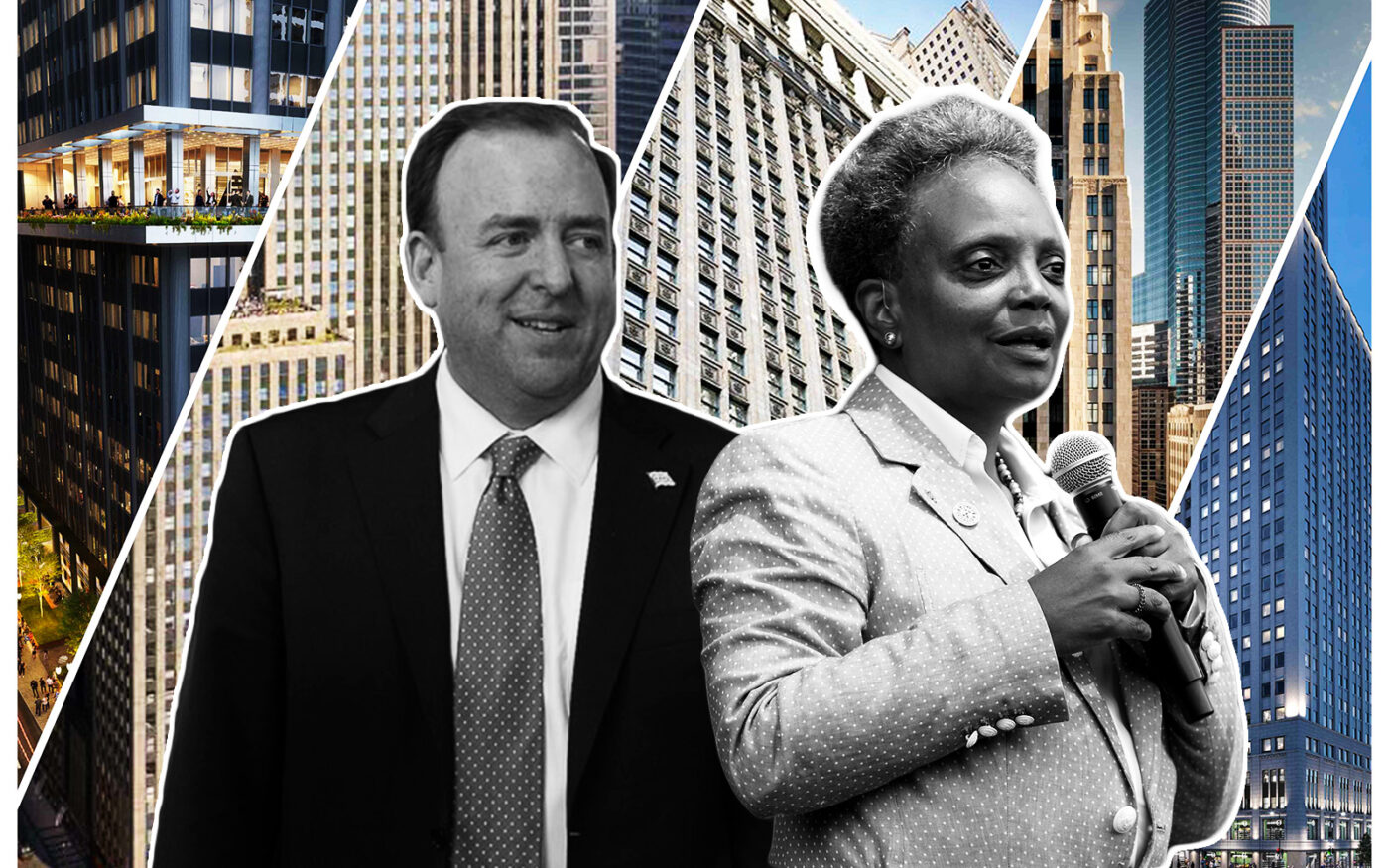Chicago weighs LaSalle’s $1.2B office-to-resi pitches
City set to select finalists amid mayoral turnover

City officials eager to move ahead with outgoing Mayor Lori Lightfoot’s push to redevelop vacant commercial space on LaSalle Street to multifamily housing mostly ignored the political elephant in the room as they touted the program and heard developers’ pitches at a virtual meeting Thursday.
The city is weighing public assistance for plans from six development teams for the “LaSalle Street Reimagined” initiative, a program whose future is unclear now that voters have rejected Lightfoot’s bid for a second term, instead sending former Chicago Public Schools CEO Paul Vallas or Cook County Commissioner Brandon Johnson to a runoff next month.
Lightfoot started the program last year hoping to revitalize the struggling LaSalle corridor, whose office buildings are faring even worse than the downtown average vacancy rate of more than 20 percent, a record high. So far, it’s unclear where Vallas and Johnson stand on continuing the initiative — some locals and real estate players believe the city can get more bang for the buck by investing in neighborhoods farther from the Loop, given a multitude of challenges and high costs associated with office-to-residential conversions.
“It would be incumbent on the next mayor to twist some arms on the city council to help build some support for it,” 42nd Ward Alderman Brendan Reilly, who represents much of the stretch of LaSalle the program is targeting, said in an interview. “If the incoming mayor isn’t interested in this, that really is the end of the conversation.”
He also conceded that Lightfoot’s goal of creating at least 1,000 new residential units downtown, with 30 percent being affordable, may be “too ambitious” for the program.
The city plans to narrow the proposals from the six collected by Lightfoot’s administration down to three by the end of this month. The proposals total more than $1 billion in development costs with about 2.3 million square feet of developable space. Selected projects would also require committee and city council approval.
Restraint on TIF
Chicago planning commissioner Maurice Cox, a Lightfoot appointee, said there are more than 5 million square feet of space in the historic commercial corridor that could be repurposed. He said the affordable housing additions would “make the heart of the Loop more resilient and dynamic on behalf of the entire city, and also more diverse.”
The city is requiring 30 percent of new units to be leased at affordable levels to be eligible to receive tax increment financing or other financial assistance from the city. Reilly, however, expects his colleagues on the city council — which, like the mayor’s office, has many seats in transition — to show some restraint on TIF spending.
That could be a problem for developers, some of whom have requested those funds for their projects. AmTrust Real Estate, for instance, requested the most of the six, at $115 million in TIF assistance for a 438-unit project costing a total of $258 million at 135 South LaSalle, while Mike Reschke and Quintin Primo’s proposal at 208 South LaSalle asked for the least in TIF at $33 million for a 280-unit project at a total cost of $130 million.
‘Rare thing’
Aldermen may prefer to pair it with projects that make use of other tax incentives, as well, Reilly said. Those include Class L tax designations — which are awarded to projects on landmarked buildings that cost at least half of what the property is worth, and lowers buildings’ tax assessments to 10 percent for 10 years, and 15 percent in the 11th year and 20 percent in the 12th — as well as other potential affordable housing subsidies available from the state or Cook County.
“There will be a limit to the amount of subsidy provided,” he said. “The attitude on city council would probably be to prefer those be Class L tax incentives, and not too heavily reliant upon TIF.”
The LaSalle/Central TIF district that would supply funding for redevelopment had a total balance of more than $196 million at the end of 2021, the most recent report available on the city’s website. But both the Lightfoot and Rahm Emanuel mayoral administrations spread money from that TIF into others across the city to help spur economic development in Chicago’s neighborhoods, as development in the downtown area required little government assistance to pencil out in the years before the pandemic created fresh challenges for the office market.
“Giving out TIF awards in the 42nd Ward has been a very rare thing. I apply a very strict ‘but-for’ test, and I would argue the LaSalle Street Reimagined certainly passes the test, but to what degree?” Reilly questioned, noting he intends to support as many “viable projects” in the program as possible. He also said some developers are willing to invest in market rate housing projects in the Loop’s core, and may abandon or avoid seeking public financing.
The campaigns for Vallas and Johnson haven’t responded to The Real Deal’s interview requests.
Some developers believe that public assistance is essential to bringing housing to the corridor.
“Without this TIF program we don’t believe there’s going to be any residential units added to LaSalle Street in the near term,” AmTrust Realty Corp.’s Patrick Kearney said at Thursday’s meeting.
Projects at a glance
- 30 N LaSalle from Golub & Co., a $173 million project that would convert 432,000 square feet of office space into 432 apartments with $75 million in TIF funding
- The Monroe Residences & Hotel at 111 West Monroe Street from Michael Reschke and Quintin Primo’s Prime Capri Interests would turn the base of the former BMO headquarters into a 226-key luxury hotel and build 349 apartments on top. The city proposal doesn’t include the hotel component; the team estimates a $180 million in development costs for the residential project and is asking for $40 million in TIF funding.
- Riverside Investment & Development and AmTrust Real Estate wants to build about 430 apartments at The Field Building at 135 South LaSalle Street and solicit a grocer for the ground floor or first two levels. Estimated development costs are $259 million, with $115 million in TIF funding.
- The Clark Adams Renewal from Celadon Partners and Blackwood Group would bring 247 apartments to 106 West Adams Street at a cost of $188 million and with $60 million in TIF funding.
- Maven Development Group is proposing to convert 333,000 square feet of office space into 423 apartments at 105 West Adams Street for $167 million with $65 million of that coming from TIF funding.
- The LaSalle Residences project from Reschke’s Prime Group would build 280 apartments at 208 South LaSalle Street for $130 million and $33 million in TIF funding.







